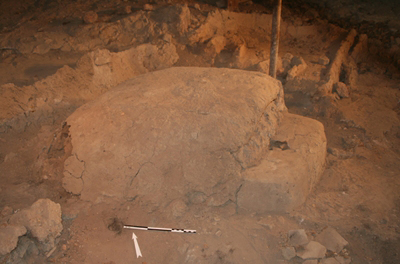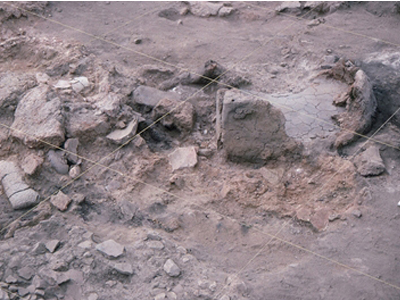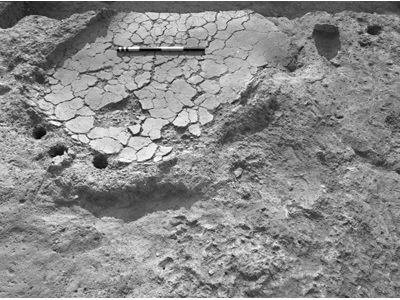Neolithic : The houses
The domestic combustion structures
 Two kinds of domestic heating structures have been recognised at the site: open (hearths)) and closed (ovens).
The most common type of hearth is flat: the foundation, which is more or less thick, is made of pebbles or sherds, or a combination of two, arranged in a pit, and covered with a layer of building clay that forms the floor, i.e. the cooking surface. This mode of construction prevents humidity from rising and thus thermally insulates the heating area. The floor is always very carefully smoothed, probably by means of a tool, perhaps a bone.
The same technique was used for the construction of the base and floor of ovens, which are distinguished from the hearths by the presence of a vaulted roof that partly covers the heating area. The oven’s floor is therefore oval or rectangular and the cooking chamber has the shape of a horseshoe with a narrow platform in front of the opening. The floor is sometimes also elevated and can be more than 15 cm higher than the surrounding room’s floor.
Two kinds of domestic heating structures have been recognised at the site: open (hearths)) and closed (ovens).
The most common type of hearth is flat: the foundation, which is more or less thick, is made of pebbles or sherds, or a combination of two, arranged in a pit, and covered with a layer of building clay that forms the floor, i.e. the cooking surface. This mode of construction prevents humidity from rising and thus thermally insulates the heating area. The floor is always very carefully smoothed, probably by means of a tool, perhaps a bone.
The same technique was used for the construction of the base and floor of ovens, which are distinguished from the hearths by the presence of a vaulted roof that partly covers the heating area. The oven’s floor is therefore oval or rectangular and the cooking chamber has the shape of a horseshoe with a narrow platform in front of the opening. The floor is sometimes also elevated and can be more than 15 cm higher than the surrounding room’s floor.
In most cases the vaulted roof has been destroyed and only fragments remain, scattered on and around the oven’s floor. Sometimes, however, it has been partially preserved, as in the case of the oven from level 3 in sector V/West (LN I), or almost entirely, like in the ovens from rooms A and B in house 4 (LN II). Their length varies from 0,80 to 1,50 m and their width from 0,70 to 0,90 m. The walls have an average thickness of 10 cm and the vault is about 30 cm high, lowering slightly towards the back.


In many cases the sides of the opening have been preserved, indicating a width of approximately 0,50 m. Vaults are constructed using coils from building clay without a wooden frame. In sector B of the Deshayes excavation they have also found ovens, but the vaults of these were constructed on wooden frames. In some examples dating from the Late Neolithic II, sherds of a fairly large size were used to shape or support the lower back side of the oven.
Those ovens are similar to many traditional ones. We have been able to determine their function thanks to a series of
experiments.

